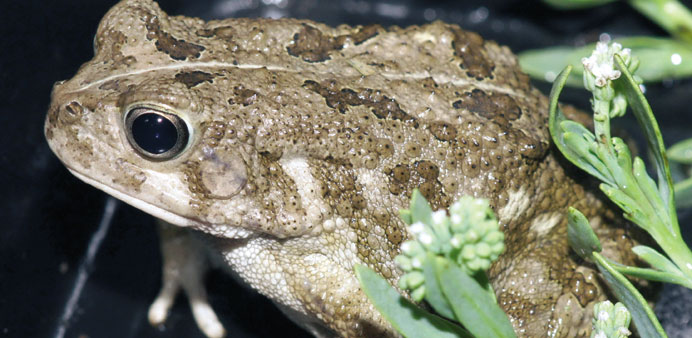The African Common Toad or Guttural Toad (Amietophrynus gutturalis). PICTURE: Michael Grunwell
By Fran Gillespie/Doha
Science teacher Henry Kavale likes to go for a spin on his bike at weekends, and while pedalling through the marshes at Al Khor recently he saw something hopping around in the waterlogged undergrowth. A toad.
On other rides he saw more of the creatures. So last weekend he sent some of his Year 10 students from Al Khor International School out to see if they could catch one for identification.
It didn’t take long; within a few minutes Henry’s son Eugene had triumphantly nabbed one of the amphibians and taken it home to be photographed.
It turned out to be a hitherto unrecorded species: the African Common Toad or Guttural Toad (Amietophrynus gutturalis). Easily recognisable from its pale dorsal stripe.
New species of fauna turn up in Qatar all the time – this dry desert country supports a surprising range of wildlife.
Animals that can adapt to the harsh weather conditions and the lack of water do well. These include reptiles, and mammals such as the Arabian Red Fox, the Ethiopian Hedgehog and the tiny Lesser Jerboa.
But toads? What is a creature that has a damp clammy skin and needs to spend part of its life in water doing in a land that, until recently, had no surface water at all?
Since the transformation of Qatar over the last few decades and the establishment of large sewage effluent lagoons, it’s become possible for amphibians to survive, even in the scorching summer months when they bury themselves deep in the mud. But the mystery is how they got here in the first place.
One possible explanation is that when the zoology department at the University of Qatar opened 40 years ago some toads were imported from Egypt for dissection in the lab. Somehow some of the animals ended up in the wild, and have been here ever since. The Egyptian Toad (Amietophrynus regularis) is well established in Qatar; its loud croaking can be heard towards sunset on any of the large lagoons.
When the Doha Golf Course opened, with its lakes and ponds, it was toad heaven! No one knows quite how they got there, but within months of the golf course opening there were toads aplenty, swimming in the lakes and meeting with accidents whenever the grass was cut. Herons and egrets fly in to feast on them.
As its name implies, the newly-identified animal is found in many African countries.
It’s an adaptable creature, living everywhere from forests to farms and savannah grasslands, and of course freshwater marshes.
Highly saline environments like the halophyte-rich coastal marshes of Qatar are not on the list of its preferred habitats. Yet it is apparently doing well here. Which just goes to show, if an animal can tolerate the extreme conditions in Qatar it will find a niche for itself and survive.

